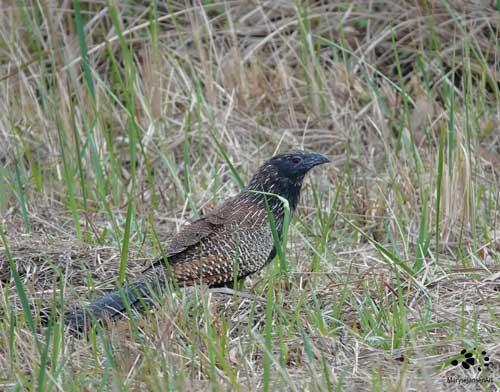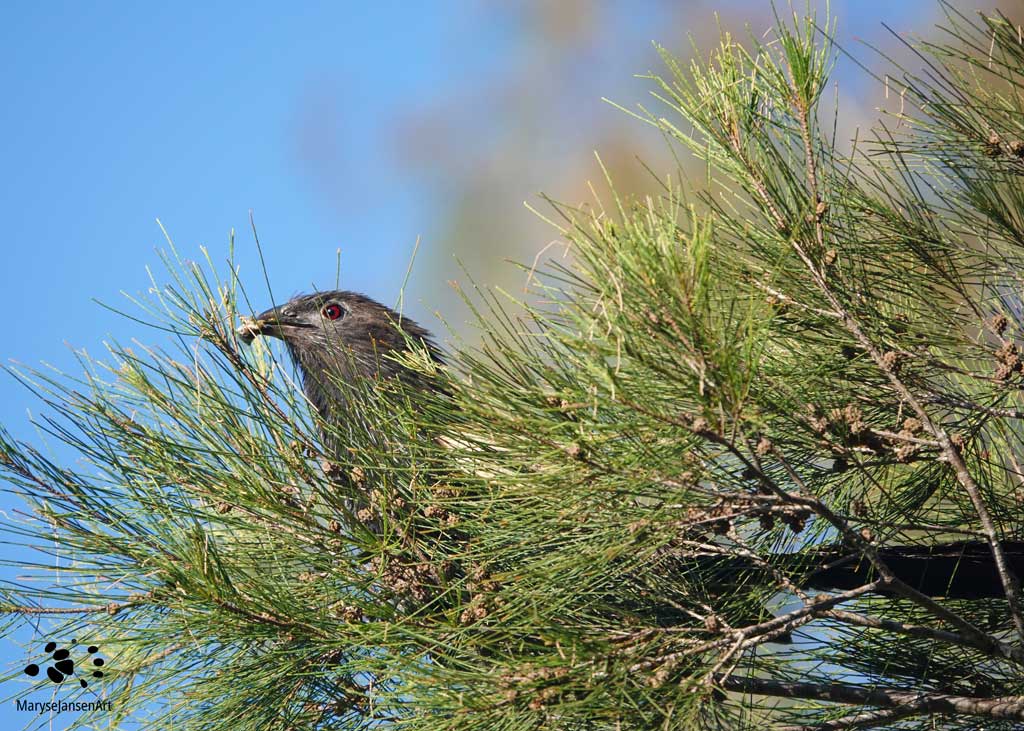Bird Photography with marysejansenart
The only Australian Cuckoo that builds its own nest!

Table of Contents
The magnificent booming call of the Pheasant Coucal
It has happened a few times now, that I’m walking through a forest or rainforest and I hear this amazing, booming bird call that carries far and wide! I’ve come to love that sound and I am so pleased to finally learn the source of it: this bird is called the Pheasant Coucal!
Check out it’s deep, hollow, booming call here:
A clumsy flyer
This bird is a large cuckoo that looks a lot like a pheasant. It is mainly brown in colour: a reddish-chestnut on top and a cinnamon brown at the underparts, boldly streaked with white. The eyes are red. The bird has short, rounded wings and a long tail, which makes it a bit of a clumsy flyer. It spends most of its time on the ground, running for cover when disturbed rather then flying. Either way, it seems they draw my attention quicker when they try to get away then when they stay put where they are.
Now that I know what I’m looking for, I notice them more often. Sometimes from the car, when they stumble on the side of the road or fly up into the trees with lots of wing flapping. Other times, when I’m on a bush walk. When I hear their call, I try to locate them but that is not an easy task as their call indeed carries a long way through the bush and they usually stop calling when you get closer. They are indeed quite shy.
Catching a Pheasant Coucal on camera
Today, I’m in luck. I hear its call, it repeats about once a minute. Slowly I come closer… It’s somewhere in the thickets here and I struggle to find it as I peer with my camera through the thick vegetation, careful not to disturb the bird…. There it is! Once more, it repeats its call while I am filming, this is amazing!! Great footage, you can watch it in the video at the end of this post.
It was, however, not the best moment for photos as part of the head was concealed by the foliage. And this is usually the way, they are quite shy of people so not easy to catch on camera…
I did have a better photo opportunity during another sighting. The bird, which was completely unaware of my presence as I had concealed myself under the branches of a tree, hopped up on a branch of a She-Oak and this brought it’s head out in full sunshine! We can get a good look at that intense red eye! And as a bonus, it was holding prey. An unlucky cicada is clenched in its bill, making a great snack! Check it out in the featured image!
Pheasant Coucals feed on large insects like cicadas and grasshoppers as well as a variety of small animals including frogs, lizards, small mammals and young birds and they also enjoy eggs.
Breeding Season: This cuckoo builds its own nest!
You may have noticed that the bird in the photo has indeed a brown colour, but the head of the bird in the video is much darker. This indicates that the bird is in breeding plumage! In breeding season the head, neck and underparts of the Pheasant Coucal turn black. You may also notice black and cream barring on the brown wings and the tail turns black with orange barring. The image below shows a bird in breeding plumage.

I saw this bird in a meadow on the side of the road. I asked the person who was driving to pull over as I opened the side window and grabbed my camera and managed to get this photo.
The interesting thing about Pheasant Coucals is that, while they are a type of Cuckoo they do not parasite on other birds’ nests. They are the only Australian Cuckoo that build their own nests and raise their own young! They breed during spring and summer and may lay multiple times per season.
Check out another Cuckoo that does lay its eggs in other birds’ nests: the Shining Bronze Cuckoo!
The nest is hidden in thick ground cover, such as tall grasses, sugar cane or weedy thickets. This vegetation also provides the building materials together with some sticks. About 3-5 eggs are laid and the incubation time is 15 days. The chicks fledge another 15 days later. The male bird does most of the work.
It’s all happening very fast for such a large species of bird! By then the chicks are actually not yet fully grown. When they leave the nest they are able to walk around but it will be a while before they can fly. Early fledging might make them less vulnerable to predation then staying in the nest for a long time.
Where can I observe these birds?
You can observe Pheasant Coucals across northern and eastern Australia anywhere where they can find. cover in dense understorey vegetation. Check out one my encounters below when you join me on my walk in the River Parklands and meet lots of other birds too!
If you are interested in purchasing ‘Pheasant Coucal’ or would like to see what the image looks like on the various products, please head to my shop.


